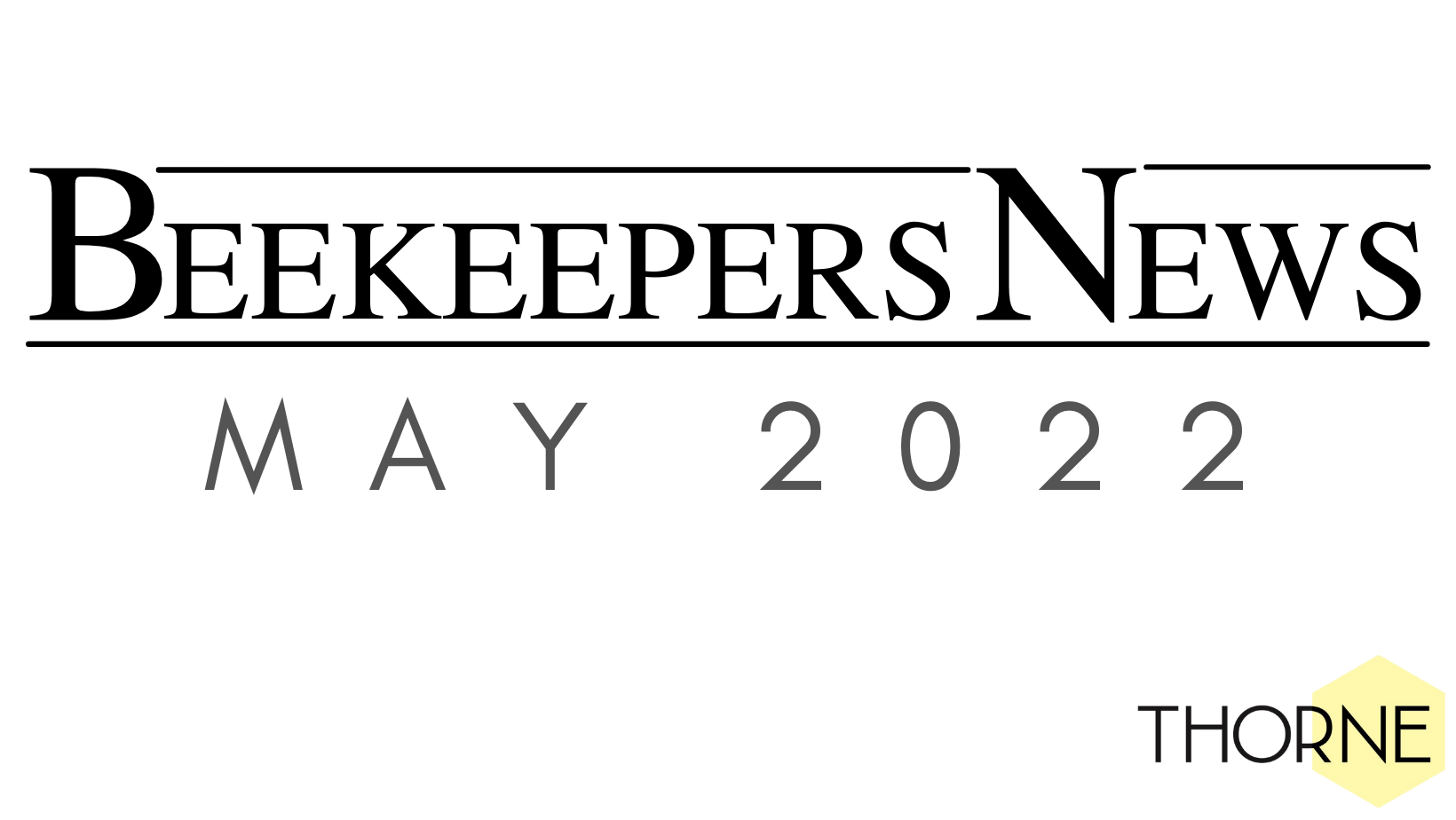|
As April wraps up, we’ve seen the first of our nuclei of bees go out to their new homes, and with that, it seems the season is in full swing again!
In this month’s newsletter we have a fantastic article written by John White of Beebuzz, looking into the different types of pollen being brought in by the bees. We also have a new blog post from Veto-pharma, a book review from Northern Bee books, and updates from the BBKA Spring Convention, the National Honey Show and Bees for Development.
Again, can we ask if you are yet to shop on our new website, please make sure you reset your password before putting any items into your basket. If you have any issues with this, you can contact us on Live Chat during office hours, or email sales@thorne.co.uk.
|
|
|
|
The National Honey Show
Ukraine Appeal
|
|
|
|
Please continue to support The National Honey Show’s initiative in recognition of our long association with the Brotherhood of Ukrainian Beekeepers.
|
|
|
|
Equipment Focus
Swarm Attractants
I have yet to meet a beekeeper who has not lost bees through swarming. It is one of those things that we know bees do, but sometimes in the rush of the season we just don’t get round to doing our swarm control in time. We come back to find our beloved queens have disappeared along with a good majority of the bees.
Swarm attractants are useful in this respect as they can be used to keep a swarm from flying out of the apiary. They are also helpful in catching swarms from elsewhere that are passing or those that have been hanging temporarily in a tree nearby.
|
|
|
|
SWARM WIPES
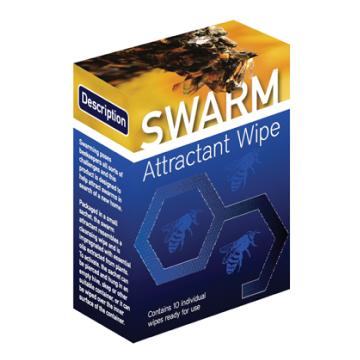
These are just like a cleansing wipe and come impregnated with essential oils to attract swarms. The sachet containing the wipe just needs to be torn or pierced and then hung in a suitable place such as a tree, a post or inside a bait hive. Before use, the wipes should be kept in the fridge.
|
|
|
SWARM LURES
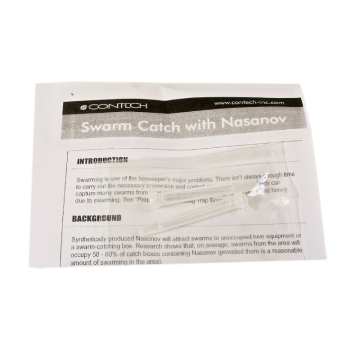
These are small phials of synthetically produced pheromone which attract swarms. The phials come with a small hoop, through which a nail can be placed, attaching it to a frame in a bait hive or other suitable place. Before use, the lures should be kept in the freezer.
|
|
|
BAIT HIVES
This is basically a spare box or hive normally placed in an existing apiary. Both the swarm lure and wipes can be used in a bait hive to encourage swarms into it. Old comb can also be used, for example some frames from another colony (disease free of course!), as the bees like the smell of the wax.
|
|
|
|
Ask The Expert
Have you ever wondered where your bees forage?
An article written by John White of Beebuzz
I am fortunate to be a member of a small group of 10 like-minded beekeepers called Beebuzz. We have been together for some 9 years. We are based in South Oxfordshire and West Berkshire. Occasionally we turn our minds to a bee-related project that interests us. Last year we decided to try and get an insight into where our bees go to forage. Do they visit gardens, agricultural plants, meadows etc? The results were surprising and very interesting.
On an agreed day each month we collected pollen samples using a Thorne plastic pollen mesh. We did it for one day only each month so as not to deprive the colonies too much of their hard-earned pollen load.
The pollen was analysed by microscopists within the group. If it was not dealt with immediately the samples were frozen to preserve them for subsequent analysis.
We collected samples from February through to September. The graph below shows the results for the month of May.
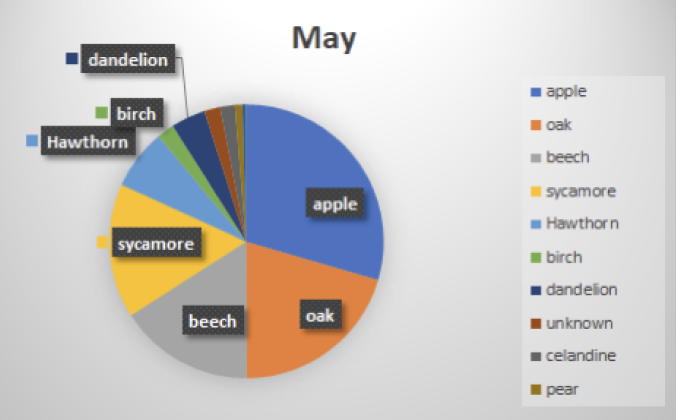
You can see our bees were visiting a wonderful mix of plants and trees. Under the microscope the individual pollen samples revealed their array of shapes and sizes.
Here are some examples:
|
|
|
|
|
|
We collected over 5,000 pollen particles. The proportion of pollen coming from trees was almost exactly 50% as shown in the chart. We then drilled down a bit more and looked at the different types of pollen both for trees and non-tree pollen.
|
|
|
The chart below shows the varying tree pollens and the relative amounts of each. Overall, for the trees we had a lot of plum and hazel Poland and fairly small amount of Birch Poland. We did a similar analysis for the non-tree pollen.
|
|
|
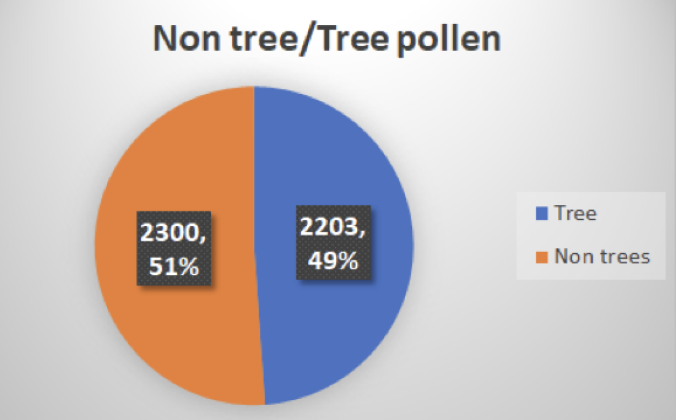
The amount of wildflower pollen compared to domestic and agricultural pollen was also interesting with fairly small volumes of commercial crops and we found our bees far preferred the pollen from wildflowers.
A project like this is far from scientific or research but it does show what a group of interested beekeepers can do together when pursuing a small part of beekeeping that is of interest.
A fuller report will be published in May’s edition of BBKA News by my fellow Beebuzz member Sue Remenyi.
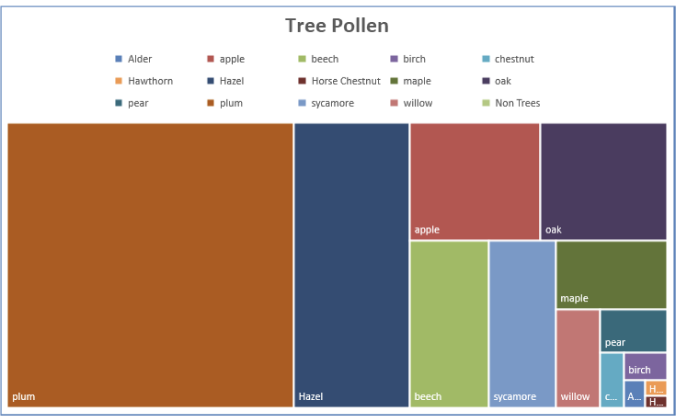
|
|
|
|
Footnote: In trawling through our many pollen samples we utilised some great resources like Rex Sawyers book and spreadsheet, plus freely available web sites. They all added something to our study. We decided to pool together our own local (to South Oxfordshire) resource for pollen identification that provides a simple and visual representation of 40 commonly found pollen samples. We are happy to provide this free of charge and simply ask that you consider making a donation to the National Honey Show Ukraine Emergency Appeal.
A project like this is far from scientific or research but it does show what a group of interested beekeepers can do together when pursuing a small part of beekeeping that is of interest.
If you have any questions, you can contact me at: smallcell@hotmail.com.
|
|
|
|
Book Review
‘Keeping Australian Native Stingless Bees’
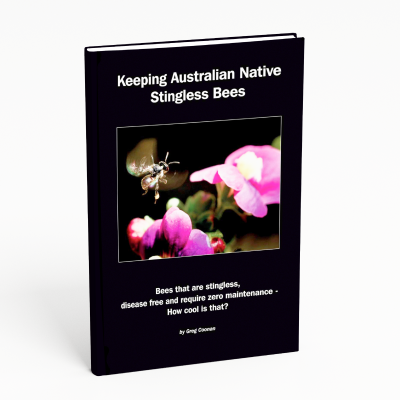
By Greg Coonan
2021 reprint, with a preface by Eva Crane
Published 2020 by Northern Bee Books
ISBN: 978-1-912271-77-1
64 pp
£14.95 from www.northernbeebooks.co.uk
In the foreword to this attractive little book, the author sets out clearly his goal, first acknowledging Tim Heard as the base source for much of his knowledge, then stating his aim as being to explore what has worked best for himself, particularly in relation to the keeping of three specific species of native, stingless (colony) bees. He lists the tree species but fails to describe one of them (Austroplebeia australis), and it is only later that he remedies this by admitting that he does not have a great deal of experience with this species and has focussed more on Tetrogonula carbonaria and Tetragonula hockingsi. For the absolute purist, there is some inconsistency in the use of italics when using scientific names, but this does not detract from the readability of the book.
The author also fails to point out that there are some 1750 plus named species of native bees in Australia, and that the three species he discusses are the only ones that form colonies, and that the rest only exist as solitary bee. He also fails to adequately state that the three species discussed are all warm-climate species, and do not survive well in colder climes such as Canberra, the NSW South Coast or States further south.
Having said all that, the author does proceed in Part 1 to give an excellent outline of the components needed to keep a colony of native stingless bees in a hive and gives very sound advice on locating and placement of a hive; even giving advice on how to keep a hive cool on days of extreme heat, plus locations/places to avoid within the micro-area of your garden. There is also a useful section on establishing a native bee-friendly garden with specific examples given.
In Part 2, the author follows up with a reasonably thorough explanation of how to:
- · Prepare the materials to propagate extra native bee colonies.
- Split hives.
- Use hive ‘education’ (budding) to induce a parent colony to colonise a second box prior to splitting. Different uses of ‘education’ are discussed – natural, assisted, revival, and capture.
- Harvest the honey from the native colony.
The last section of the book covers hive rescue and relocation (removing a hive from its bush setting) [from a wide range of situations such as logs, structures – houses, walls etc – and even from water meters] and management of pests – Phorid flies, Syrphid flies and African small hive beetle.
All in all, an entertaining book with a large amount of information to get the novice enthusiast started, and to enable the keeping of more hives once a certain level of proficiency has been attained.
By Des Cannon - Editor, The Australasian Beekeeper
|
|
|

Blog
Springtime in your bee colonies –
Lay a solid foundation for a healthy season!
As the days are getting longer, and we are all looking forward to those extra rays of sunshine, you are not alone in the desire to stretch your legs and get fit for the warm season. Your bees are “stretching their antennae” too – so to speak – to prepare for a new colony buildup. Eggs are already being laid, and as soon as the first flowering sets in and pollen and nectar become available, forager bees are beginning to fly out to collect much-needed nutrition for the colony.
Although varroa may not be your very first thought when you check upon your bees after the long winter months, this time of the year offers you an opportunity that will not return until the next winter treatment is due at the end of the year. Many of us begin the New Year with new resolutions, considering what we would like to implement change, clean-up, renew, or improve things in our lives, our homes, or about ourselves. As beekeepers, hive management, bee health and nutrition, and economic goals for the upcoming season are likely to represent some of the themes of our New Year resolutions.
One way to realize those well intended resolutions and improve honey bee health early in the season, is to start considering varroa treatments as soon as you plan the first visit to your hives. We know that the amount of bee brood in our colonies will increase in the upcoming weeks and months.1 We also know that the development of the varroa population is somewhat lagging behind bee brood development, which makes perfect sense, as varroa mites need the presence of bee brood to be able to reproduce at all.1 This sheer fact in addition to seasonally low monitoring numbers can lead beekeepers to think: Out of sight, out of mind. Meaning, as long as there is no significant varroa infestation present in the hives yet, why think of varroa treatments?
While it is certainly not time - or cost-effective to treat against varroa mites too often or with a mite load of (almost) zero (Psssst! It’s never really “zero”...), early spring treatment offers you the opportunity to reduce varroa mite and viral pressure in your colonies early on. Beekeepers often focus on the late summer or fall treatment, and for good reason. Varroa mite counts after the honey harvest are high1, treatment thresholds have constantly decreased over the last years, and treatment timing has become a matter of colony survival after the summer. However, it is precisely the lack of bee brood that provides opportunity for a quicker and more effective treatment in early spring, before the first honey flow.
Most miticides target varroa mites when they are attached to their adult bee hosts and thus openly exposed to any potential treatment. Mites in the capped brood cannot be reached until they emerge from the brood cell. Thus, it will not come as a surprise to you that treatments are more effective, the less mites are “hiding out” in bee brood cells. The ideal example of this is the winter treatment with oxalic acid in completely brood-free colonies, a few weeks after the first frost.
Although the bee brood already begins to grow in spring, the total amount of brood present in the hives before the first honey flow is low enough to ensure ideal conditions for an efficient and thorough clean-up1, reducing the mite load before the honey season significantly. A mite treatment applied in time before setting up your honey supers for the first time in spring ensures a lower infestation rate through the season. Make sure you select a treatment that can be used with lower temperatures without impairing the efficacy. Your colonies will thank you for reduced mite numbers throughout the season and some added benefits for colony health.
References: 1 – Alexis L. Beaurepaire, Klemens J. Krieger and Robin F.A. Moritz – Seasonal cycle of inbreeding and recombination of the parasitic mite Varroa destructor in honeybee colonies and its implications for the selection of acaricide resistance – 2017
|
|
|
|
Auction at the BBKA
Spring Convention
In aid of the National Honey Show DEC Ukraine Appeal
|
|
|
|
Saturday’s Auction, after the Quiz Dinner during the recent BBKA Spring Convention at Harper Adams, was originally an idea to gain maximum benefit from a demo hive made during Friday’s ‘Build Your Own Hive’ Workshop.
|
|
|
|
Stephen Barnes (BBKA Chair & Saturday’s Quiz master) was enthusiastic about bringing his gavel! Gill Smith offered that Thorne could sponsor the extra flat-pack hive and asked Protek to donate blue & yellow paint. Further rapid agreement ensued from Oliver St John (Workshop tutor), Gareth Morgan (steward & painter) and Bob Maurer, Chair of the National Honey Show, whose appeal we were suggesting contributing to.
|
|
|
|
|
|
A few speculative e-mails later, and the auction of one hive grew wings, as other lots were suggested. Indeed, the number of lots and the dramatic change in value of lots originally intended as affordable, became slight concerns.
|
|
|
A signed copy of Bob Maurer’s Microscopy book was augmented by two microscopes (huge thanks to Brunel). BeeCraft offered ‘a commissioning editor opportunity’; National Bee Supplies a stay in a bee-hive lodge, with lunch and a factory tour. Then there were Sara Robb’s goody-bag; jars from Freeman & Harding; a smoker from Abelo; BBWear gloves; stewarding with John Goodwin & a signed copy of his book (thanks to Northern Bee Books). Lower value items (a box of my honey and a fruitcake baked by Tim Lovett) were included mainly to get the bidding going!
|
|
|
|
As the evening unfolded, any worries that lots might struggle to reach acceptable reserves proved unfounded. Enthusiastic bidding saw Tim’s cake being fought over (to much hilarity) in £1 increments, by Convention Committee members.
|
|
|
|
Then there was a lot I had presumed I could win: For several years I have been keen to spend a day beekeeping with John Hendrie (BBKA Trustee and NHS President). Whilst he was in Kent, this was unlikely to happen, but as he is moving to Kinross, it seems more likely and might even be prioritised if I had paid (maybe £50) for the privilege…. As the bidding soared well beyond £100, I belatedly realised that I wasn’t the only member of John’s fan-club. Indeed, the wild amounts offered if he would do another day’s beekeeping at Stoneleigh, mean that several days with John have raised more than each of the other individual ‘higher value’ items.
From the germ of an idea, through the generosity of donors and bidders, the auction directly contributed more than £1,700 for the NHS DEC Ukraine appeal and further donations were made during the event. Despite the horrors of the situation in Ukraine, there was an atmosphere of camaraderie in the room - with shared enthusiasm and collective pleasure when winning bids were made. An unexpected highlight to a special weekend.
or further donations to the appeal, click here:
Joyce Nisbet, BBKA Trustee and Spring Convention Committee Chair
|
|
|
|
Bees for Development
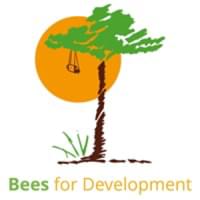
Big Give Green Campaign
We have just concluded our Big Give Green Campaign, raising funds for our work in the forests of South Uganda, where Batwa communities suffer tremendously because of changes in land use and exclusion, resulting in extreme poverty. These people are forced to live on steep slopes outside the forests that were once their home. We are working with the Batwa, helping them to create income from beekeeping: which is proving feasible and highly popular.
Please do donate if you can – it is never too late! beesfordevelopment.org
Prestigious Award
We are delighted to have won the Hub Cymru Africa (funded by the Welsh Govt) Sustainable Partnership Award, recognising our enduring collaboration and work with TUNADO – The Uganda National Apiculture Development Organization. There are over 300 partnerships between Wales and Sub-Saharan Africa, and we are thrilled that the judges recognised our special relationship with our partner organisation in Uganda.
RHS Chelsea Flower Show 24-28 May
Thornes have built us the most beautiful stand for Chelsea! It is a feat of skilled, precision carpentry – a series of hexagons that will enclose our small tropical forest – demonstrating the great power of bees to help improve the lives of rural communities, restore biodiversity and combat climate change. Our presence at RHS Chelsea is sponsored by Rowse Honey and by Thornes – please do come and say hello to us in the Great Pavilion if you are planning to visit Chelsea this year.
|
|
|
|
National Honey Show
NEW: Pre-centenary competitive classes for the 2022 Show
NATIONAL HONEY SHOW SPECIAL PRE-CENTENARY CLASSES.
Entries are invited for these three special classes to design items to celebrate the centenary of the Show in 2023. A condition of entry that the design may be used by the show, though copyright remains with the designer. (No entry fee)
82.Design for Centenary Bunting.
Three different designs to fit triangular bunting 200mm at the top and 300mm long. Each design to be submitted on an A4 page.
First: £10; Second: £7; Third: £5.
83. Design a Flag for the Centenary.
The finished flag size TBD (please check later)
Entries to be submitted on an A4 page.
First: £10; Second: £7; Third: £5.
84. Design Logo for the Centenary Medal.
The medal size will be 40mm diameter.
Entries to be submitted on an A5 sheet.
First: £10; Second: £7; Third: £5.
EThe full show schedule of classes is now available on our website: honeyshow.co.uk/download-schedule.php
Deadline for receiving entry forms for these, and most other classes: 10th October 2022.
May 2022 Lecture Video Release
The May YouTube video release from the 2021 lecture series will be “Natural conditions of bees living in tree cavities” by Torbin Schiffer. Tune in from 5.15pm on Friday 6th May: youtube.com/c/NationalHoneyShowUK/videos and please support the show by subscribing to our channel.
National Honey Show Leaflets
If you would like some leaflets with information about this year’s National Honey Show for distribution to members of your association, and at local or county shows, please let Val know how many you would like and where to send them to: publicity@honeyshow.co.uk.
Similarly, if you would like copies of our children’s leaflets detailing the children’s entry classes for your family, local beekeeping families and/or school, scout group etc, contact Val as above.
Look forward to seeing you at this year’s show: 27th to 29th October 2023 at Sandown Park Racecourse, Esher, Surrey.
|
|
|
Upcoming Events
- 12th & 13th August – Thornes of Scotland Sale Day
- 3rd September – Thornes of Windsor Sale Day
- 17th September – Thornes of Stockbridge Sale Day
- 24th September – Thornes of Devon Sale Day
- 8th October – Rand Sale and Open Day
- 27th - 29th October – The National Honey Show
|
|
|
|
